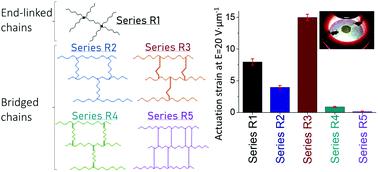当前位置:
X-MOL 学术
›
Polym. Chem.
›
论文详情
Our official English website, www.x-mol.net, welcomes your feedback! (Note: you will need to create a separate account there.)
Silicone dielectric elastomers optimized by crosslinking pattern – a simple approach to high-performance actuators
Polymer Chemistry ( IF 4.6 ) Pub Date : 2020-03-24 , DOI: 10.1039/d0py00223b Codrin Tugui 1, 2, 3, 4 , George T. Stiubianu 1, 2, 3, 4 , Manole S. Serbulea 4, 5, 6, 7, 8 , Maria Cazacu 1, 2, 3, 4
Polymer Chemistry ( IF 4.6 ) Pub Date : 2020-03-24 , DOI: 10.1039/d0py00223b Codrin Tugui 1, 2, 3, 4 , George T. Stiubianu 1, 2, 3, 4 , Manole S. Serbulea 4, 5, 6, 7, 8 , Maria Cazacu 1, 2, 3, 4
Affiliation

|
Silicone elastomers are one of the most promising materials for dielectric elastomer transducers (DETs). In the context of the intense research that is being done to improve the electromechanical performances, in terms of dielectric permittivity, Young's modulus and dielectric strength, through increasingly complex, sophisticated approaches, the simple way of optimizing the base polymer seems to have remained less explored. Depending on the real-world applications, these materials can easily be optimized in terms of mechanical and electromechanical properties by using appropriate molecular weight and crosslinking pattern. To demonstrate this, multiple series of silicone elastomer films differing by crosslinking pattern and molecular weight were prepared. Various crosslinking chemistries, more or less common for silicones, were addressed: condensation, dehydrocoupling, hydrosilylation and thiol–ene addition, leading to networks with end-crosslinked or bridged chains topologies, in the latter case the bridges having different lengths and flexibilities. The uniaxial and cyclic stress–strain tests showed a substantial change in the mechanical behaviour through variation of the two structural parameters mentioned. In addition, the crosslinking density determined by solvent swelling method correlate to the mechanical behaviour. Thus, the UV cured elastomeric networks, series R3, showed the lowest Young's modulus, ranging from 0.06 MPa to 0.32 MPa depending on the molecular weight of the involved polymer. By using same polymers as for series R3 but with a different crosslinking pattern based on hydrosilylation reaction of vinyl groups, series R5, the resulting elastomers exhibited a Young's modulus of about twenty times larger and an elongation at break below 50%. The data collected for the series of silicone films demonstrates the choice of optimum molecular weight and crosslinking pattern leads to elastomers without mechanical losses, dielectric strength over 100 V μm−1 or lateral strain of 15% at only 20 V μm−1. This twofold chemical optimization results in materials with targeted properties that can easily be adapted for real-life applications.
中文翻译:

通过交联模式优化的有机硅弹性体–一种简单的高性能执行器方法
有机硅弹性体是介电弹性体换能器(DET)最具前景的材料之一。在为改善机电性能而进行的大量研究的背景下,通过越来越复杂,复杂的方法,在介电常数,杨氏模量和介电强度方面,优化基础聚合物的简单方法似乎仍未得到充分研究。 。根据实际应用,可以通过使用适当的分子量和交联方式轻松地对这些材料的机械和机电性能进行优化。为了证明这一点,制备了一系列交联图案和分子量不同的有机硅弹性体薄膜。解决了各种交联化学,或多或少是有机硅常见的:缩合,脱氢偶联,氢化硅烷化和硫醇-烯的添加,导致网络具有末端交联或桥连的链拓扑,在后一种情况下,桥具有不同的长度和柔性。单轴和循环应力应变测试表明,通过改变上述两个结构参数,机械性能发生了实质性变化。另外,通过溶剂溶胀法测定的交联密度与机械性能相关。因此,取决于所涉及的聚合物的分子量,系列R3的UV固化的弹性体网络显示出最低的杨氏模量,范围为0.06MPa至0.32MPa。通过使用与R3系列相同的聚合物,但基于乙烯基的氢化硅烷化反应,其交联方式有所不同,R5系列 所得的弹性体表现出约二十倍的杨氏模量和低于50%的断裂伸长率。针对一系列有机硅薄膜收集的数据表明,选择了最佳的分子量和交联图案可形成没有机械损耗,介电强度超过100 Vμm的弹性体-1或仅在20 Vμm -1下的横向应变为15%。这种双重化学优化可产生具有目标特性的材料,可以轻松地将其应用于现实生活中。
更新日期:2020-03-24
中文翻译:

通过交联模式优化的有机硅弹性体–一种简单的高性能执行器方法
有机硅弹性体是介电弹性体换能器(DET)最具前景的材料之一。在为改善机电性能而进行的大量研究的背景下,通过越来越复杂,复杂的方法,在介电常数,杨氏模量和介电强度方面,优化基础聚合物的简单方法似乎仍未得到充分研究。 。根据实际应用,可以通过使用适当的分子量和交联方式轻松地对这些材料的机械和机电性能进行优化。为了证明这一点,制备了一系列交联图案和分子量不同的有机硅弹性体薄膜。解决了各种交联化学,或多或少是有机硅常见的:缩合,脱氢偶联,氢化硅烷化和硫醇-烯的添加,导致网络具有末端交联或桥连的链拓扑,在后一种情况下,桥具有不同的长度和柔性。单轴和循环应力应变测试表明,通过改变上述两个结构参数,机械性能发生了实质性变化。另外,通过溶剂溶胀法测定的交联密度与机械性能相关。因此,取决于所涉及的聚合物的分子量,系列R3的UV固化的弹性体网络显示出最低的杨氏模量,范围为0.06MPa至0.32MPa。通过使用与R3系列相同的聚合物,但基于乙烯基的氢化硅烷化反应,其交联方式有所不同,R5系列 所得的弹性体表现出约二十倍的杨氏模量和低于50%的断裂伸长率。针对一系列有机硅薄膜收集的数据表明,选择了最佳的分子量和交联图案可形成没有机械损耗,介电强度超过100 Vμm的弹性体-1或仅在20 Vμm -1下的横向应变为15%。这种双重化学优化可产生具有目标特性的材料,可以轻松地将其应用于现实生活中。



























 京公网安备 11010802027423号
京公网安备 11010802027423号